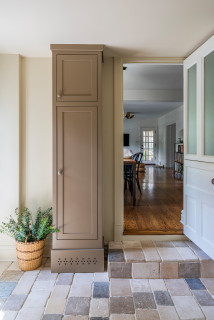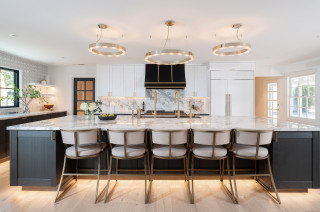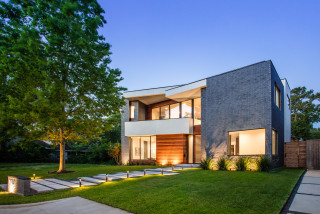
This article was originally published by a www.houzz.com . Read the Original article here. .

This article was originally published by a www.houzz.com . Read the Original article here. .

The experts we spoke to agree: Surrounding yourself with the right people as your business grows is one of the most important steps to success. So what do seasoned design-business owners value most in a candidate? “Passion is No. 1,” says Julie Cavanaugh, founder and principal designer at Design Matters, which operates five studio showrooms in Northern California; Jackson, Wyoming; and Park City, Utah. “If a candidate has a resume that is not exactly what we are in need of but [the skills] can be trained and developed, then I evaluate that candidate based on passion, commitment, team approach and overall fit for culture. If the passion is there, the rest can be taught.”
Alex Secki, operations coordinator at Muse Residential in Concord, North Carolina, says: “I look for candidates who demonstrate strong organizational skills, attention to detail and the ability to collaborate across departments. Additionally, I seek individuals who are adaptable, capable of working in fast-paced environments and have a willingness to learn.”
15 Lasting Design Ideas From the Best of Houzz 2025 Award Winners
This article was originally published by a www.houzz.com . Read the Original article here. .
The average completion time of a single-family house in 2023 was approximately 10.1 months, breaking down to 1.5 months for authorization to start construction and another 8.6 months to finish construction. According to the Census Bureau’s Survey of Construction, the permit-to-completion time has been on an upward trend since 2015. Currently, it is almost 3 months longer than the average completion time in 2015. This extended duration is largely attributable to a more stringent regulatory environment, ongoing supply-chain challenges and a shortage of skilled labor.
Among all single-family houses completed in 2023, homes built for sale required the shortest amount of time, 8.9 months from obtaining building permits to completion. Meanwhile, homes built by owners (custom builds) required the longest time, 15.2 months. Homes built by hired contractors tookabout12.1 months, and homes built-for-rent took about 12.2 months from authorization to completion.
The time from permit to start for all types of homes was longer in 2023. The period of time necessary to start construction required, on average, 1.5 months in 2023. In contrast, prior to 2017 construction typically started within the same month after obtaining building authorization. Between authorization and the start of construction, built for sale and built by contractors on owner’s land required 1.5 months and 1.4 months respectively. The permit-to-start time was even longer for homes built-for-rent and custom builds (1.6 months).
The chart below illustrates that permit-to-completion time differs across home sizes. The smallest single-family homes, under 1,200 sq. ft., required 13 months to finish, relatively longer than larger homes under 5,000 sq. ft. This prolonged period is primarily because half of these smaller homes are constructed specifically for rental purposes, which typically takes longer building time from authorization. In contrast, homes ranging from 1,200 to 3,999 sq. ft. are built at the average building time, typically around 10 months. As the size increases beyond 4,000 sq. ft., there is a noticeable upward trend in completion times. Homes with 4,000-4,999 sq. ft. take about 12 months, while those between 5,000- 5,999 sq. ft. extend to a little more than 14 months. Homes over 6,000 sq. ft. take the longest to build, requiring almost 18 months from permit to finish.
The average time from authorization to completion also varies across divisions. The division with the longest duration was New England (13.9 months), followed by the Middle Atlantic (13.2 months), the Mountain division (11.4 months), and the Pacific division (11.2 months) in 2023. These four divisions exceeded the nation’s average of10.1 months. The shortest period, 8.9 months, is registered in the South Atlantic division. The average waiting period from permit to construction start varies from the shortest time of 0.9 months in the East North Central to the longest of 2 months in New England.
The SOC also collects additional information for houses built for sale, including a sale date when buyers sign sale contracts or make a deposit. Looking at single-family homes built for sale and completed in 2023, 17.2% were sold before construction started, 41.8% sold while under construction, 15.6% sold during the month of completion, and 19.7% sold after completion. The share of completed houses remaining unsold was 5.8% at point of survey.
Discover more from Eye On Housing
Subscribe to get the latest posts sent to your email.
This article was originally published by a eyeonhousing.org . Read the Original article here. .

Whether you’ve been in business for a few years or two decades, each new client brings fresh challenges. Make sure to listen carefully and tune in to their requests, personality quirks and body language.
Take time to learn about who your clients are. Listen to their fears, what makes them excited and how they want their home to feel. “Pay close attention to those special things they really care about,” says Angel Riveros, designer at AIR Studio. “Make them feel you are on their side, that you are there to support and make their dream space come true. If you build trust, no inconvenience will be too big to overcome.”
This article was originally published by a www.houzz.com . Read the Original article here. .
Crown molding, picture rails, wainscoting, hand-hewn banisters and balusters and other decorative trim brought dimension and artisanal flair to older homes. Beyond their beauty, these details often served practical purposes, including concealing imperfect seams and protecting plaster walls from scuffs and dents. While modern materials and construction methods make those functions less necessary, trim and paneling still provide a sense of craftsmanship and permanence that can instantly add character to a new build.
Your home’s architecture offers cues for the decorative trim that will suit it best. Victorians and Colonial Revival moldings tended to be taller and more ornate, for example, whereas Craftsman homes often kept trims simpler and chunkier, with visible joinery. These broader architectural styles can be broken down even further into subsets with their own signature details, so it’s important to be on the same page with your designer or architect about which style you’re after and carry it through the house for consistency.